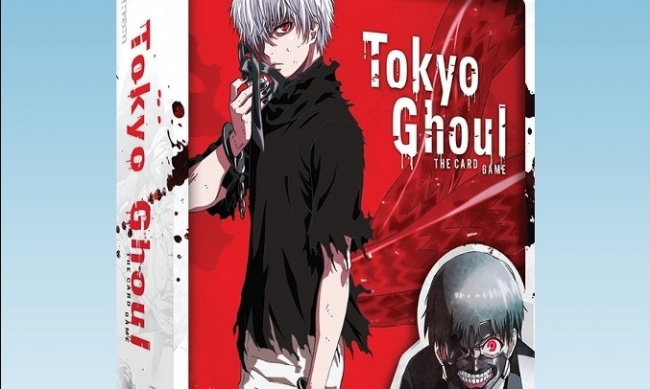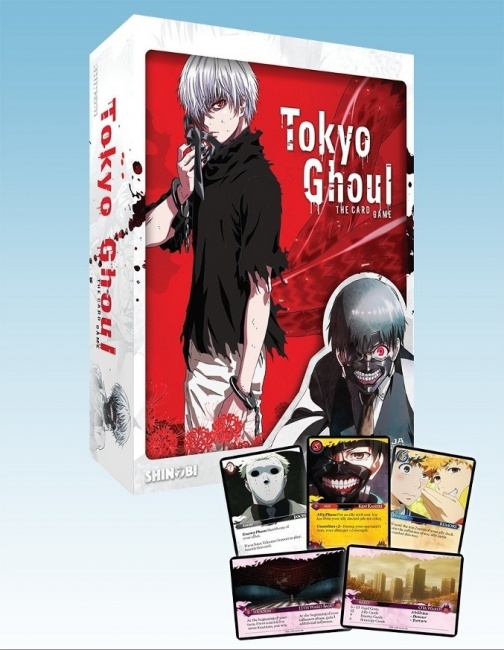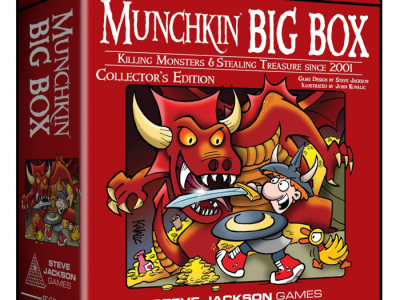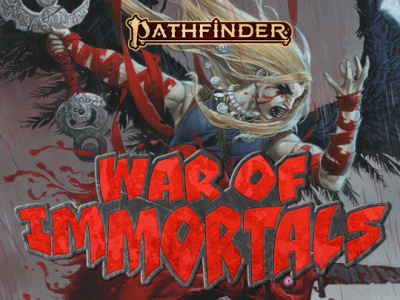Tokyo Ghoul: The Card Game
Publisher: Shinobi 7 / Ninja Division
Release Date: December, 2017
Price: $34.99
Game Designer: Ryan Miller
Format: Card Game
Number of Players: 2 to 4
Playing Time: 30-60 minutes
Product #: NJD440201
Age Rating: 10+
ICv2 Rating: 3.5 Stars out of 5
First, a confession: Before I was shown Tokyo Ghoul: The Card Game, I had no knowledge of Sui Ishida’s dark fantasy manga series, though apparently, it’s a pretty big deal. In the manga, flesh-eating ghouls manipulate Tokyo from the shadows, waging a hidden war between them for control of the underworld while certain equally-shadowy government agencies seek to hunt them down. An intriguing idea, but does it translate well into the deck builder game genre?
Summary: As a powerful ghoul, players recruit and deploy their "allies" to advance their goals, ultimately extending their power (in the form of victory points) over the city. Interestingly, the ghouls do nothing themselves—every action is undertaken by the allies, who use their "influence" to recruit additional minions to the cause—or to manipulate "enemies," government agents and vigilantes, into attacking another faction—or their "strength" to attack the allies of a rival ghoul. Some even have special abilities or talents that can give their ghoul an edge.
Mechanically, Tokyo Ghoul has the trappings of the now-familiar deck building game. Each player has their own deck of cards that evolves over the course of the game, and those cards provide the resources to acquire new cards. This is combined with a simple combat system based on a straight-forward comparison of strength values and a king-of-the-hill scenario where players try to hold a trio of "location" cards. If a player can hold them through a full round, they win the game. Alternatively, collecting 10 victory points—mostly awarded by keeping ones allies alive—will also earn a victory
Originality: One of the interesting things to observe as the deck building category continues to mature and evolve is the subtle changes that designers make to the core concepts of the genre. Here, Miller has introduced a couple ideas, familiar from traditional card games, that helps create the atmosphere of secrecy and intrigue at the heart of the Tokyo Ghoul story. Rather than purchasing cards from a publicly-available pool, each player has their own hand of cards that only they can acquire cards from: Ally cards that go into the player’s deck, enemies that go to another player’s deck, and one-shot strategy cards that are played directly from the hand. This hand of cards is not drawn from the player’s own deck, but instead from a set of shared draw piles. Each pile has a different mix of cards, and choosing which pile to draw from proves to be a critical element of the strategy.
Presentation: The game is illustrated with artwork taken from the source, so the entire game has the same dark, gritty, and vaguely disturbing look of the manga, and shows the quality that one would expect from Japanese comics. Due to the source material, this does leave the cover a bit dark, and with a limited palette that offers little more than black, white, and red. Nonetheless, the red-eyed staring ghoul on the cover does arrest the attention, and let’s face it: if you’re a fan of Tokyo Ghoul, this is probably the look you’re after.
Quality: The cards themselves are good quality and should stand up well to repeated play, with information that is presented in a clear way. For the most part, the card effects are easy to understand and clear, though it may seem odd at first that some keywords refer to how an effect is played, rather than a description of what the effect does. Two allies with "recruit" abilities could have wildly different effects, for example. But once that is understood, few card effects should cause confusion. Victory points are tracked with a set of nice, thick cardboard tokens emblazoned with large, easy to read numbers. The rulebook is well-laid out and the rules are clear, with good examples and illustrations. I would have liked more of both, but what is there is quite readable.
Marketability: Tokyo Ghoul: The Card Game should appeal both to fans of the manga and fans of deck building games, as there are elements to appeal to both groups. Knowledge of the manga won’t have any bearing on ones ability to play the game, but manipulating familiar characters is always fun. Gameplay is quick, and most players will pick up on strategies pretty easily during their first play, and games are quick enough that playing again won’t strain its welcome. For the first play, I think the time on the box is a bit optimistic, but once everyone is familiar with the system turns play quickly with little downtime. Speaking of the box, it’s a bit large for the 216 cards inside (room for future expansions, maybe?), leaving a fair amount of empty space inside, which may aggravate some considering the price point.
Overall: Supernatural creatures secretly manipulating humanity from the shadows has been a popular theme for a long time, and it’s one that works surprisingly well for a deck building game like Tokyo Ghoul. One can easily imagine their cabal of minions pursuing dark ends, their network slowly expanding as cards are added to their deck, or contracting as forces remove their allies from their network. The design offers some very interesting variations on the now-familiar mechanics, offering intriguing ways to plan and develop strategies that are not always possible in other deck builders.
Speaking as one who doesn’t know the source material, I can’t say if the game fully captures the feel of the manga, but I do think that the game mechanics fit the theme described well, and those mechanics offer an interesting twist to the still-developing deck builder genre. That’s why I’m giving this game 3.5 out of 5.
-- William Niebling

ICv2 Stars: 3.5 (out of 5)
Posted by William Niebling on February 1, 2018 @ 3:10 am CT
MORE GAMES
Both Old and New with Many Extras
April 18, 2024
Steve Jackson Games will release Munchkin Big Box , with over 650 cards by John Kovalic, both reprint and new, and many extras.
Ties Together Rulebooks, Setting, Adventures, and Fiction
April 17, 2024
Paizo has announced War of Immortals, a Pathfinder RPG “meta-event” that ties together rulebooks, setting, adventures, and fiction around a single storyline.
MORE REVIEWS
ICv2 Stars: 3.5 (out of 5)
February 23, 2024
Here's a review of The Lucy Poor graphic novel, published by Iron Circus.
ICv2 Stars: 4 (out of 5)
February 20, 2024
Here's a review of Nina Simone in Comics, published by NBM Publishing.








